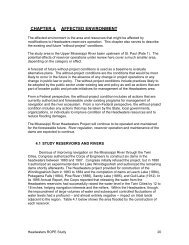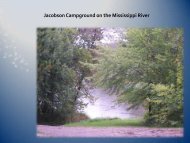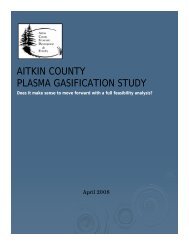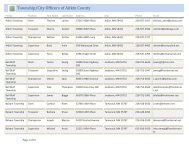Aitkin County Shoreland Homeowner's Guide to Lake Stewardship
Aitkin County Shoreland Homeowner's Guide to Lake Stewardship
Aitkin County Shoreland Homeowner's Guide to Lake Stewardship
Create successful ePaper yourself
Turn your PDF publications into a flip-book with our unique Google optimized e-Paper software.
✓ Practice Water Conservation<br />
Too much water flowing in<strong>to</strong> the tank will cause the tank <strong>to</strong><br />
back up and lead <strong>to</strong> ineffective treatment of wastewater. To<br />
prevent this:<br />
• Repair all leaky faucets, fixtures, and appliances.<br />
• Install low water-use fixtures and appliances (especially<br />
<strong>to</strong>ilets and shower heads).<br />
• Do not empty roof drains and sump pump water in<strong>to</strong><br />
the septic system.<br />
• Wash only full loads of clothing and dishes, and<br />
spread out water use, such as laundry, throughout the<br />
day and week. Consider front loading machines; they<br />
use less water.<br />
• Reduce the length of showers and the number of <strong>to</strong>ilet<br />
flushings, especially during high use periods.<br />
• Reroute water softener discharge water out of the<br />
septic system.<br />
• Do not hook floor drains or drain tile in<strong>to</strong> the septic<br />
system.<br />
✓ Limit What Goes Down the Drain<br />
• Do not put household cleaners, paint, solvents, medications,<br />
and other chemicals down the drain.<br />
• Limit the use of antibacterial products. As the name<br />
suggests, they can reduce the amount of working<br />
bacteria in the septic tank.<br />
• Use only the recommended amounts of liquid nonphosphorus<br />
detergents and cleaners.<br />
• Prevent food particles, grease, lint, coffee grounds,<br />
plastics, and other non-degradable solids from getting<br />
in<strong>to</strong> the system.<br />
• Use single-ply <strong>to</strong>ilet paper for the best decomposition.<br />
✓ Do Not Use System Additives<br />
It is not necessary <strong>to</strong> use starters, feeders, cleaners, or<br />
other septic additives <strong>to</strong> enhance the performance of your<br />
system. If your system is properly maintained and operated,<br />
it will operate at maximum performance with the use of<br />
naturally occurring bacteria.<br />
✓ Protect Your Drainfield<br />
Compacting or obstructing the soil over the treatment area<br />
can cause malfunctioning of the drain field. To protect it:<br />
• Keep heavy vehicles off the drainfield.<br />
• Maintain vegetative cover, but do not plant trees or<br />
shrubs on the drainfield because the roots may penetrate<br />
and clog the distribution system.<br />
• Mow the area, but do not fertilize or water.<br />
• Reroute roof drains and drain tile away from the<br />
drainfield.<br />
Protect Your System from<br />
Freezing in the Winter<br />
Common causes of septic system freezing during the winter<br />
can be lack of snow cover, extreme cold, compacted snow,<br />
irregular use of the system, leaking plumbing fixtures, pipes<br />
not draining properly, or a water-logged system.<br />
What <strong>to</strong> do if the system freezes Unplug your pump<br />
and call a septic system professional. Do not add<br />
antifreeze, additives, or continuously run water <strong>to</strong> try <strong>to</strong><br />
unthaw the system.<br />
To prevent freezing, follow these general guidelines:<br />
• Fix any leaking plumbing or appliances prior <strong>to</strong> winter.<br />
• In the fall, leave the grass longer over the tank and<br />
drainfield for better insulation.<br />
• Add a layer of hay or straw mulch (8-12 inches) over<br />
the pipes, tank, and soil treatment area.<br />
• Keep ATVs and snowmobiles off the drainfield.<br />
• Spread hot water use (laundry, showers, dishwasher)<br />
out over the day and week. If you’ll be gone for<br />
extended periods, consider having someone s<strong>to</strong>p by<br />
<strong>to</strong> run hot water regularly.<br />
• High efficiency furnaces, water softeners, and iron filters<br />
have the potential <strong>to</strong> cause problems in the winter<br />
because of slow and/or periodic discharges of<br />
water. For suggested precautions, see:<br />
http://septic.umn.edu/homeowner/factsheets/furnacessoftnersironfilters.html<br />
• Talk with a professional before installing heat tapes or<br />
tank heaters.<br />
<strong>Aitkin</strong> <strong>County</strong> Requirements<br />
Who regulates The design, inspection, and installation of<br />
septic systems are regulated by <strong>Aitkin</strong> <strong>County</strong> and must be<br />
done by professionals licensed by the state. Lists of<br />
licensed professionals and permits for septic system installation<br />
can be obtained from the Planning & Zoning office.<br />
What records are required All septic systems must<br />
have a Certificate of Compliance indicating they meet the<br />
<strong>Aitkin</strong> <strong>County</strong> ISTS and Wastewater Ordinance, sometimes<br />
referred <strong>to</strong> as being “up-<strong>to</strong>-code.” A Certificate is good for<br />
five years from the date of original installation, and must<br />
be renewed every three years thereafter.<br />
When are inspections required If you are applying for a<br />
building permit for new construction, a compliant septic<br />
system is required. A building permit for any addition <strong>to</strong><br />
current buildings, including a deck or garage—attached or<br />
non-attached, requires a current Certificate of Compliance<br />
for the septic system. If one is not on record or it is not<br />
current, an inspection of the septic system will be required<br />
and, if the system is found <strong>to</strong> be noncompliant, modification<br />
or replacement of the system may be necessary<br />
before a building permit is issued.<br />
What about property transfers A Certificate of<br />
Compliance is required before a title transfer can occur on<br />
any shoreland property with a septic system. If the system<br />
is not compliant, it must be brought in<strong>to</strong> compliance, or an<br />
agreement must be filed <strong>to</strong> update/escrow for later compliance<br />
before occupancy and title transfer <strong>to</strong> new owner.<br />
Call the <strong>Aitkin</strong> <strong>County</strong> Planning & Zoning Office for questions<br />
about septic system requirements, including setbacks<br />
from property lines, wells, lakes, rivers, and streams.<br />
Page 5








